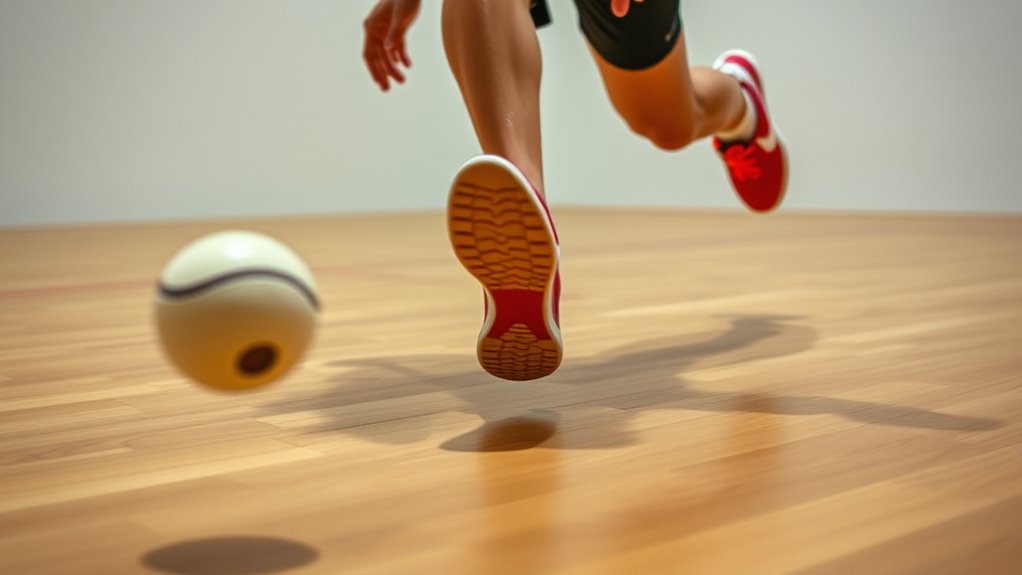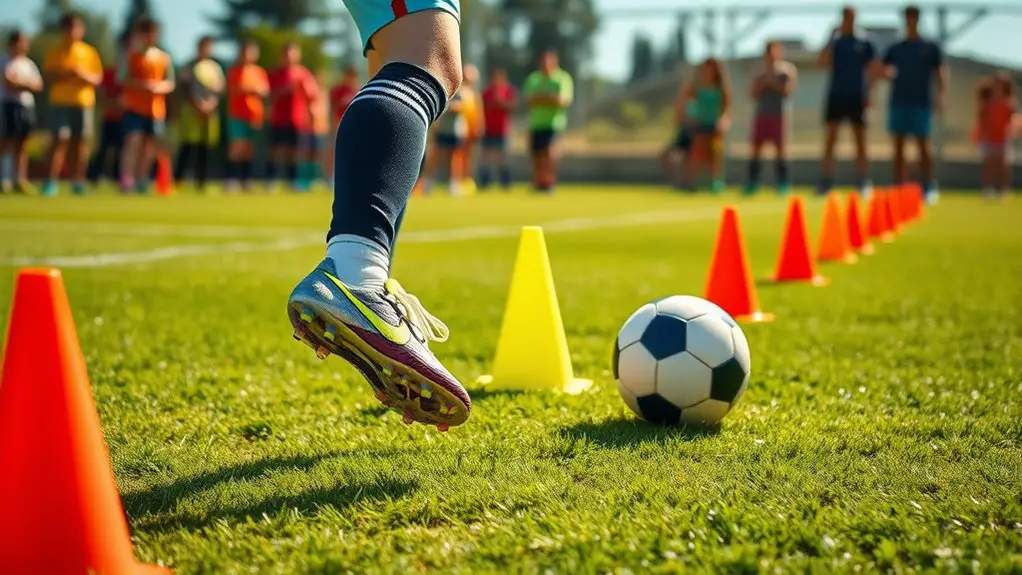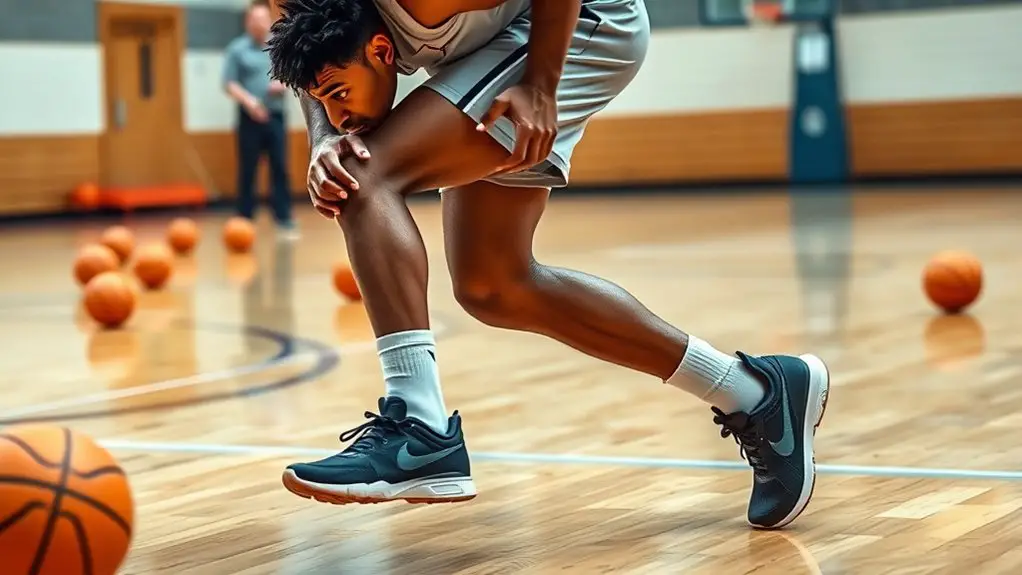To improve your vertical jump for basketball, focus on mastering jump mechanics, including proper alignment and energy release. Incorporate plyometric exercises like box jumps and depth jumps to boost explosiveness. Strength training with squats and deadlifts builds the muscle needed for power. Don't forget about flexibility and mobility through dynamic warm-ups. Finally, pay attention to your nutrition for peak performance. If you apply these tips, you'll be on your way to jumping higher in no time!
Understanding the Mechanics of Vertical Jump
When you think about improving your vertical jump, it's essential to understand the mechanics behind it. Jump biomechanics play a key role in how high you can leap. Fundamentally, it's all about how your body moves and generates force. To maximize your jump, you need to focus on proper alignment and coordination of your muscles.
When you bend your knees and prepare to explode upward, you're storing energy in your muscles. This energy needs to be released efficiently for ideal force generation. Engaging your core and using your arms to propel yourself upward can enhance this process. Additionally, incorporating plyometric exercises into your training routine can significantly improve your explosiveness and overall leg power.
Essential Plyometric Exercises
To boost your vertical jump, incorporating essential plyometric exercises is key. You'll want to focus on techniques like box jumps and depth jumps, which offer unique benefits, as well as plyometric push-ups for overall power. These exercises can greatly enhance your explosiveness on the court. Additionally, proper form during these exercises is essential to maximize gains and reduce injury risk.
Box Jumps Technique
Box jumps are a powerful plyometric exercise that can greatly enhance your vertical leap for basketball. They improve explosive strength, coordination, and overall athleticism, making them a must for any serious player. To perform box jumps effectively, stand with your feet shoulder-width apart, bend your knees slightly, and explode upward onto a sturdy box. Land softly with your knees slightly bent to absorb the impact.
To maximize box jumps benefits, explore various box jumps variations, like lateral jumps or single-leg jumps, to target different muscle groups and keep your workouts fresh. Incorporating these techniques into your training routine not only boosts your vertical jump but also contributes to your freedom of movement on the court. Embrace the challenge, and watch your game elevate!
Depth Jumps Benefits
While many exercises can boost your vertical jump, depth jumps stand out as one of the most effective plyometric drills. They're designed to enhance your explosive power, giving you that extra edge on the court. Here are a few benefits of incorporating depth jumps into your training routine:
- Increased Reactive Strength: Depth jumps improve your ability to respond quickly, enhancing your overall agility.
- Enhanced Muscle Recruitment: They activate more muscle fibers, helping you build strength and speed in your jumps.
- Improved Jump Mechanics: With consistent practice, you'll refine your jumping technique, making your leaps more efficient.
Plyometric Push-Ups Effectiveness
Plyometric push-ups can be a game-changer for your upper body strength and explosiveness, especially in basketball. By incorporating this exercise into your routine, you'll reveal significant plyometric benefits that enhance your overall performance. Plus, with various push-up variations, you can keep your workouts fresh and challenging.
| Push-Up Variation | Focus Area | Plyometric Benefit |
|---|---|---|
| Standard Plyo Push-Up | Chest and Triceps | Increased explosive power |
| Clap Push-Up | Upper Body Power | Enhanced reaction speed |
| Staggered Push-Up | Stability and Balance | Core engagement |
| Medicine Ball Push-Up | Coordination | Improved force transfer |
| Single-arm Push-Up | Unilateral Strength | Increased muscle activation |
Try these variations and watch your game elevate!
Strength Training for Jumping Power
To elevate your vertical jump, incorporating strength training into your routine is crucial. Building explosive strength is key to achieving that extra lift on the court. Here are three effective strategies to enhance your jumping power:
- Squats: Utilize powerlifting techniques to develop your leg muscles. Focus on deep squats to engage your glutes, hamstrings, and quads, which are essential for jumping.
- Deadlifts: This compound movement strengthens your posterior chain, giving you the explosive power needed to launch off the ground.
- Box Jumps: Incorporating box jumps into your routine can improve your explosive strength. Aim for maximum height while ensuring proper form and landing softly to prevent injury. Additionally, exercises like Olympic lifts can further enhance your coordination and timing, key factors for achieving greater verticality.
Flexibility and Mobility for Better Jumps
Improving your vertical jump isn't just about strength; flexibility and mobility play an essential role in your overall performance. To release your jumping potential, focus on dynamic stretching and enhancing your hip mobility. When your muscles and joints are limber, you can achieve a greater range of motion, which translates into higher jumps. Additionally, prioritizing mobility training reveals athletic potential and allows for expression in sport.
| Dynamic Stretching Exercises | Benefits | Frequency |
|---|---|---|
| Leg Swings | Increases hip mobility | 3-5 times/week |
| Walking Lunges | Improves flexibility | 3-5 times/week |
| High Knees | Enhances warm-up | Before workouts |
| Butt Kicks | Activates leg muscles | Before workouts |
| Arm Circles | Increases upper body flexibility | Before workouts |
Incorporate these exercises into your routine, and you'll feel more freedom in your movements, allowing for more explosive jumps on the court.
Nutrition Tips for Optimal Performance
While training your body to jump higher is essential, what you fuel it with can make just as much of a difference in your performance. To maximize your vertical jump, consider these nutrition tips:
- Meal Timing: Eat a balanced meal or snack containing carbs and protein about 1-2 hours before you train. This'll give you the energy you need without weighing you down.
- Hydration Strategies: Stay hydrated before, during, and after workouts. Dehydration can zap your energy and hinder your performance, so drink plenty of water or electrolyte-rich fluids. Proper hydration is vital for athletes to avoid fatigue and cramps.
- Post-Workout Nutrition: Refuel your body with a protein-rich meal or shake within 30 minutes after training. This helps repair and build muscle, ensuring you bounce back stronger.
Technique and Form Improvement
Fueling your body properly sets the stage for effective training, but honing your technique and form can make a significant impact on your vertical jump. Start by focusing on your jumping posture. Stand tall with your feet shoulder-width apart, knees slightly bent, and your core engaged. This alignment guarantees you're ready to explode upward.
When you jump, use your arms to gain momentum—swing them upward as you push off the ground. This coordinated movement enhances your lift, helping you reach greater heights.
Equally important is your landing technique. Aim for a soft landing by bending your knees and absorbing the impact. This not only prevents injuries but also prepares you for your next jump. Additionally, incorporating plyometric exercises into your training can further enhance your explosiveness. By refining your jumping posture and landing technique, you'll notice improvements in your vertical jump, giving you the freedom to soar higher on the court.
Incorporating Jump Training Into Your Routine
To really boost your vertical jump, you need to integrate jump training into your routine. Start with proper warm-up exercises to prep your muscles, then focus on plyometric techniques for explosive power. Consistency is key, so keep track of your progress to stay motivated and make adjustments as needed. Incorporating essential plyometric exercises can greatly enhance your power, speed, and agility.
Warm-Up Exercises Importance
Incorporating effective warm-up exercises into your routine is essential for improving your vertical jump in basketball. Not only do dynamic warm ups prepare your muscles and joints, but they also enhance your performance while promoting injury prevention. Here are three key warm-up exercises to evaluate:
- Leg Swings: Stand next to a wall and swing one leg forward and backward to loosen your hip flexors.
- High Knees: Jog in place, bringing your knees up to your chest to activate your muscles and increase your heart rate.
- Butt Kicks: While jogging, kick your heels toward your glutes to engage your hamstrings.
Plyometric Training Techniques
Plyometric training can greatly boost your vertical jump, making it an essential component of your basketball practice. Incorporate these advanced plyometrics into your routine for explosive power while ensuring you focus on injury prevention.
| Exercise | Benefits |
|---|---|
| Box Jumps | Increases explosiveness |
| Depth Jumps | Enhances reactive strength |
| Plyometric Push-Ups | Builds upper body power |
| Single-Leg Hops | Improves balance and strength |
Start with basic movements and gradually progress to more advanced techniques. It's vital to maintain proper form to minimize injury risks. Remember, your freedom to jump higher relies on consistent training and smart choices. Embrace the challenge and elevate your game!
Consistency and Progress Tracking
While it might be tempting to jump right into intense training, consistency and progress tracking are essential for improving your vertical leap. To make your jump training routine more effective, focus on these key aspects:
- Goal Setting: Define clear, measurable goals for your vertical jump. This helps keep you motivated and focused.
- Routine: Incorporate jump training into your regular workout schedule. Consistency is key to seeing real improvements.
- Progress Evaluation: Regularly assess your jump height and overall performance. Adjust your training methods based on your findings to keep pushing your limits.
Tracking Progress and Setting Goals
To effectively enhance your vertical jump for basketball, tracking your progress and setting clear goals are vital. Start by defining specific, measurable goals—like increasing your jump height by a certain number of inches within a set time frame. This way, you know exactly what you're aiming for, and it fuels your motivation.
Progress tracking is just as important. Keep a journal or use an app to record your jump heights, workout routines, and any changes you notice. Regularly reviewing this data helps you see how far you've come, allowing you to adjust your training as needed. Additionally, ensure that your goals are SMART criteria so that they are clear and attainable.
Celebrate small victories along the way; they'll keep your spirit high and your focus sharp. Remember, the journey toward improvement is just as important as the end goal. By setting clear objectives and diligently tracking your progress, you'll pave the way for greater freedom and success in your basketball game.
Frequently Asked Questions
How Does Body Weight Affect Vertical Jump Performance?
Body weight plays a vital role in vertical jump performance. If you've got a higher body composition, it can limit your ability to jump higher. However, strength training can help you build muscle while managing your weight. By focusing on lean muscle development, you can improve your power-to-weight ratio, allowing you to leap higher. Staying light yet strong gives you the freedom to achieve your jump potential without unnecessary burden.
Are There Specific Shoes That Enhance Vertical Jumping?
When it comes to specific shoes that enhance vertical jumping, jumping shoes can play a significant role. These specialized athletic footwear often feature lightweight materials and cushioning that support explosive take-offs. While they won't magically boost your jump, the right pair can provide better grip and comfort, allowing you to focus on your technique. So, if you're looking for that extra edge, investing in quality jumping shoes might just be your ticket to freedom in the air!
Can Jumping Higher Reduce the Risk of Injuries?
Did you know that athletes with better jump technique can reduce their injury risk by up to 50%? When you focus on improving your vertical leap, you're not just soaring higher—you're also enhancing your injury prevention strategies. Mastering jump technique guarantees your body absorbs impact better, keeping you free to enjoy the game. So, as you work on your hops, think about how it's not just about height, but safety too!
What Role Does Mental Focus Play in Jumping Higher?
Mental focus plays a huge role in your ability to jump higher. By using mental visualization, you can picture yourself soaring through the air, which helps boost your confidence and performance. Incorporating concentration techniques, like deep breathing and mindfulness, will keep distractions at bay, allowing you to fully commit to your jump. When your mind is clear and focused, you're more likely to release your true potential and achieve that height you desire.
How Often Should I Rest During Jump Training?
When it comes to jump training, you need to balance effort with rest intervals. It's important to give your muscles time to recover, so consider taking short breaks every few sets. Aim for at least one full rest day each week to avoid burnout. Listen to your body; if you're feeling fatigued, don't hesitate to adjust your training frequency. Freedom in your routine will help you stay motivated and make progress!




